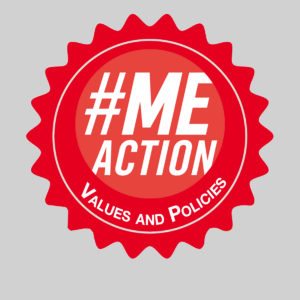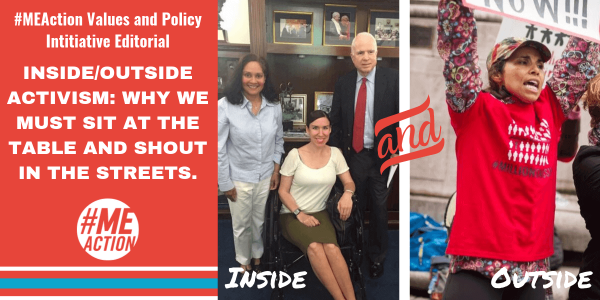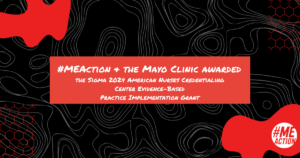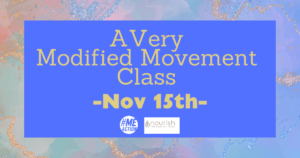Values & Policy Initiative
This article is part of our Values & Policy Initiative, a six-month long process for the community to come together to learn and discuss our core values, tactics and positions so that we are more unified in our work as a large, diverse community. This process will culminate in a statement of principles and values as well as a formal policy platform, which the community will ratify with an up-or-down vote. Visit our Values & Policy webpage to see published articles, and our timeline for discussion. #MEActionVPI
Join our upcoming Community Call to discuss our values and tactics on Wednesday, October 30th at 10 am PT / 1 pm ET / 6 pm UK
Listen to the article:
About the Author: Jim Eigo was on the front lines of activism when AIDS began devastating the gay community in New York in the eighties. He was a core member of ACT UP and the Treatment & Data Committee. He helped design two reforms of AIDS drug regulation, accelerated approval and expanded access, reforms that facilitated the delivery of many treatments to people across the world. In 2012 he returned to ACT UP to work on HIV Prevention issues and to co-author the NY State Blueprint to put an end to the AIDS epidemic. He retired from this work in 2017.
 It wasn’t until several years into the AIDS epidemic, 1987, that the activist group ACT UP arose. ACT UP erupted because lots of people in the communities directly affected by AIDS finally realized that there was a political dimension to the AIDS crisis. Marginalized people, gay men, injection drug users and their partners and children, were being allowed to die. Only after our communities took direct power would we secure for ourselves and those we loved the relief we needed. So we organized our communities and marched en masse on the halls of power, including the halls inhabited by the medical establishment. We made a lot of noise and before long we got a lot of press.
It wasn’t until several years into the AIDS epidemic, 1987, that the activist group ACT UP arose. ACT UP erupted because lots of people in the communities directly affected by AIDS finally realized that there was a political dimension to the AIDS crisis. Marginalized people, gay men, injection drug users and their partners and children, were being allowed to die. Only after our communities took direct power would we secure for ourselves and those we loved the relief we needed. So we organized our communities and marched en masse on the halls of power, including the halls inhabited by the medical establishment. We made a lot of noise and before long we got a lot of press.
But almost as soon as ACT UP formed, a group within ACT UP realized: it would not be enough to inform the world of our plight and put the people in power on notice that we’d be holding them responsible for the epidemic’s burgeoning death toll. We, the AIDS community, were the real experts on an epidemic that was baffling the people who had the power. We would have to design the policies that would save us. To do that we’d have to make ourselves expert in the arcane fields of drug regulation and research. Even while we demonstrated on the outside, our goal was to blast down the doors and make our way inside where we could make effective policy.
HIV at the time seemed so strange and forbidding: a bit like ME today, another condition that has devastated the lives of so many people living with the condition and the lives of their loved ones. But ME does have some unique problems. There is no definition everyone agrees on for the condition. We don’t know if there is one causative agent for ME or several contributing factors. We don’t have biomarkers for ME that would guarantee the correct diagnosis or to figure out whether potential treatments are helpful. Unlike with HIV, there is not a growing death count to pressure the establishment into getting serious. Nor are people living with ME concentrated in particular demographic groups or in urban centers which can aid in gaining political clout and getting heard.
The ME community understands far better than I what it needs from the medical establishment. I can list some of what AIDS activists did to win our treatment victories:
- We made sure our initial demands of the medical establishment were simple and concrete. Those demands in skeletal form served in rallying our troops and informing the press of what we wanted.
- We quickly expanded those simple demands into full-blown policies we wrote as if we had the power to put them into effect.
- We targeted the people in the medical establishment (in the US, the Food & Drug Administration, the National Institutes of Health and the Centers for Disease Control) that could make real change and quickly.
- We found friends in the federal medical institutions who would speak up and act in our behalf.
- We invited local caregivers to contribute to the policies we were writing and become advocates for their implementation.
- We found sympathetic journalists to get the word out, and did it ourselves with all available media.
- We found politicians who would support us.
- We embarrassed the medical establishment into addressing us and our concerns.
- We convinced the medical establishment they needed us: People living with a difficult medical condition, their loved ones and their caregivers are the experts on the condition, and, as such, an indispensable resource to a medical establishment that hopes to address it.
- We made clear to the medical establishment that we wanted not just a place at the table but seats on all relevant medical research and regulatory committees, and that we would not be mere observers on those committees: We would be full partners in changing existing policies and making new ones that addressed the real-world epidemic we knew so well.
I don’t know how much of the playbook that we used in securing effective treatment for HIV can be retooled for use by ME activists. But from the incredibly savvy ME advocates I have met and worked with, I am pretty sure you will take what you need as you prevail upon often ignorant and uncaring institutions that the cure for ME is you.
Visit our Values & Policy webpage to read published articles, see the timeline for discussion and join community calls. #MEActionVPI







3 thoughts on “Inside / Outside Activism: Why We Must Shout in the Streets and Sit at the Table.”
Don’t suffer or activity or street.
The CFS/ME need cure.
Cure may easy and instantly.
1. Detect the pathogenic source
2. Remove the pathogenic source
3. Reboot the body control systems.
Thank you for well written articles. All sensible.
Elemental problem to getting sufficient funding and research: we are not a sympathetic group. Insufficient imagery of suffering; no reports of deaths caused by ME/CFS; no known at risk population to take up the fight because they’re next to be stricken; and if you are afflicted but can still fulfill life responabilites, you go about doing so: once you can’t you are left only able, perhaps, to write some letters and send some shoes to a protest.
We need a spokesperson- a star who is influential and persuasive and who is motivated (by their own or a loved one’s ME, or by money, or any combination) to carry the message. The afflicted can’t fight, those who love them are consumed with care giving, and only a tiny few others care because no thinks they are at risk for a disease that to most doesn’t exist. We need to enlist the star, the entertainer, pro athlete, author, adventurer, who has or loves someone who has ME, to lead the charge. Jen Brea has been amazing but she almost died in her efforts. We need someone who already has name recognition and popularity; someone who Congress and Parliament and The New York Times and the NIH will want to hear from, someone who will be a multiplier and acceleratant to all the hard work that many wonderful people have invested so far.
Lady Gaga is the one who comes to mind straight away for fibromyalgia.
Sinead O’Connor – was it ME/CFS that she suffered?
Comments are closed.